2016 Hyundai Azera warning
[x] Cancel search: warningPage 481 of 521

Maintenance
64
7
Always handle them carefully, and
avoid scratches and abrasions. If
the bulbs are lit, avoid contact with
liquids.
Never touch the glass with bare hands. Residual oil may cause the
bulb to overheat and burst when lit.
A bulb should be operated only when installed in a headlight.
If a bulb becomes damaged or cracked, replace it immediately
and carefully dispose of it.Headlight (HID type)
If the light bulb does not operate,
have the vehicle checked by an
authorized HYUNDAI dealer.
OHD076046
WARNING
-
HID Headlight low beam
Do not attempt to replace or
inspect the low beam (XENON
bulb) due to electric shock dan-
ger. If the low beam (XENON
bulb) is not working, have your
vehicle checked by an author-
ized HYUNDAI Dealer.
WARNING - Halogen
bulbs
Handle halogen bulbs with care. Halogen bulbs contain
pressurized gas that will pro-
duce flying pieces of glass that
could cause injuries if broken.
Wear eye protection when changing a bulb. Allow the
bulb to cool down before han-
dling it.
CAUTION
If your vehicle is equipped withHigh Intensity Discharge (HID)headlights, these headlightscontain mercury. So if you needto have your vehicle disposed,you should remove the HIDHeadlights before disposal. Theremoved HID headlights shouldbe recycled, re-used or dis-posed as hazardous waste.
Page 487 of 521
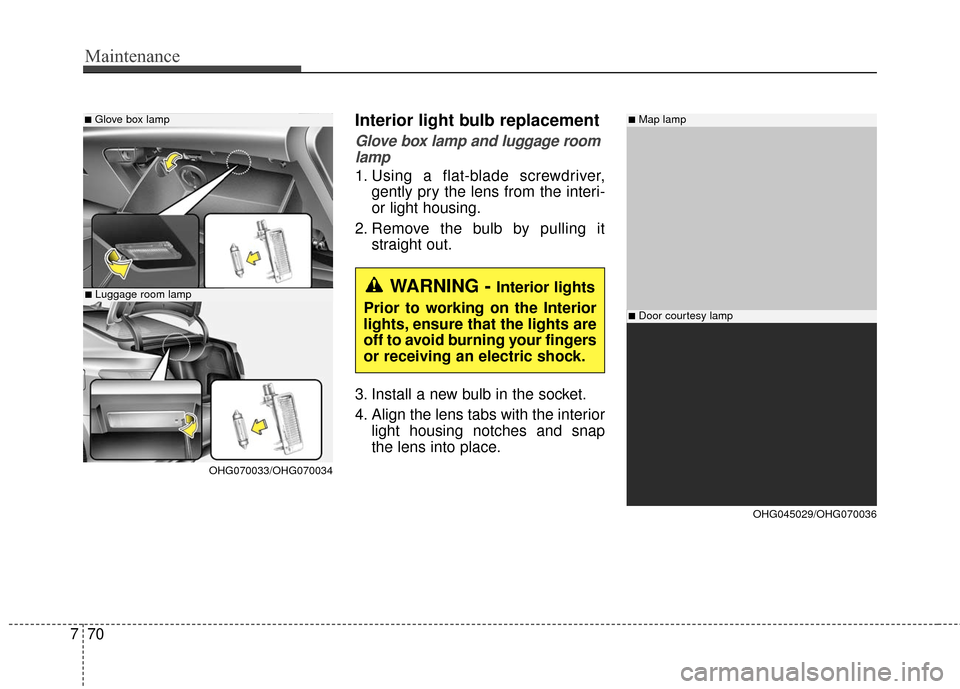
Maintenance
70
7
Interior light bulb replacement
Glove box lamp and luggage room
lamp
1. Using a flat-blade screwdriver, gently pry the lens from the interi-
or light housing.
2. Remove the bulb by pulling it straight out.
3. Install a new bulb in the socket.
4. Align the lens tabs with the interior light housing notches and snap
the lens into place.
WARNING - Interior lights
Prior to working on the Interior
lights, ensure that the lights are
off to avoid burning your fingers
or receiving an electric shock.
■Glove box lamp
■Luggage room lamp
OHG070033/OHG070034
■Map lamp
■Door courtesy lamp
OHG045029/OHG070036
Page 489 of 521

Maintenance
72
7
Exterior care
Exterior general caution
It is very important to follow the label
directions when using any chemical
cleaner or polish. Read all warning
and caution statements that appear
on the label.
High-pressure washing
When using high-pressure wash-
ers, make sure to maintain suffi-
cient distance from the vehicle.
Insufficient clearance or excessive
pressure can lead to component
damage or water penetration.
Do not spray the camera, sensors or its surrounding area directly with
a high pressure washer. Shock
applied from high pressure water
may cause the device to not oper-
ate normally.
Do not bring the nozzle tip close to boots (rubber or plastic covers)or
connectors as they may be dam-
aged if they come into contact with
high pressure water.
Finish maintenance
Washing
To help protect your vehicle’s finish
from rust and deterioration, wash it
thoroughly and frequently at least
once a month with lukewarm or cold
water.
If you use your vehicle for off-road
driving, you should wash it after each
off-road trip. Pay special attention to
the removal of any accumulation of
salt, dirt, mud, and other foreign mate-
rials. Make sure the drain holes in the
lower edges of the doors and rocker
panels are kept clear and clean.
Insects, tar, tree sap, bird droppings,
industrial pollution and similar
deposits can damage your vehicle’s
finish if not removed immediately.
Even prompt washing with plain water
may not completely remove all these
deposits. A mild soap, safe for use on
painted surfaces, may be used.
After washing, rinse the vehicle thor-
oughly with lukewarm or cold water.
Do not allow soap to dry on the finish.
APPEARANCE CARE
CAUTION
Do not use strong soap, chem- ical detergents or hot water,and do not wash the vehicle indirect sunlight or when thebody of the vehicle is warm.
Be careful when washing the side windows of your vehicle.Especially, with high-pressurewater, water may leak throughthe windows and wet the inte-rior.
To prevent damage to the plastic parts and lamps, donot clean with chemical sol-vents or strong detergents.
WARNING - Wet brakes
After washing the vehicle, test
the brakes while driving slowly
to see if they have been affected
by water. If braking performance
is impaired, dry the brakes by
applying them lightly while main-
taining a slow forward speed.
Page 497 of 521
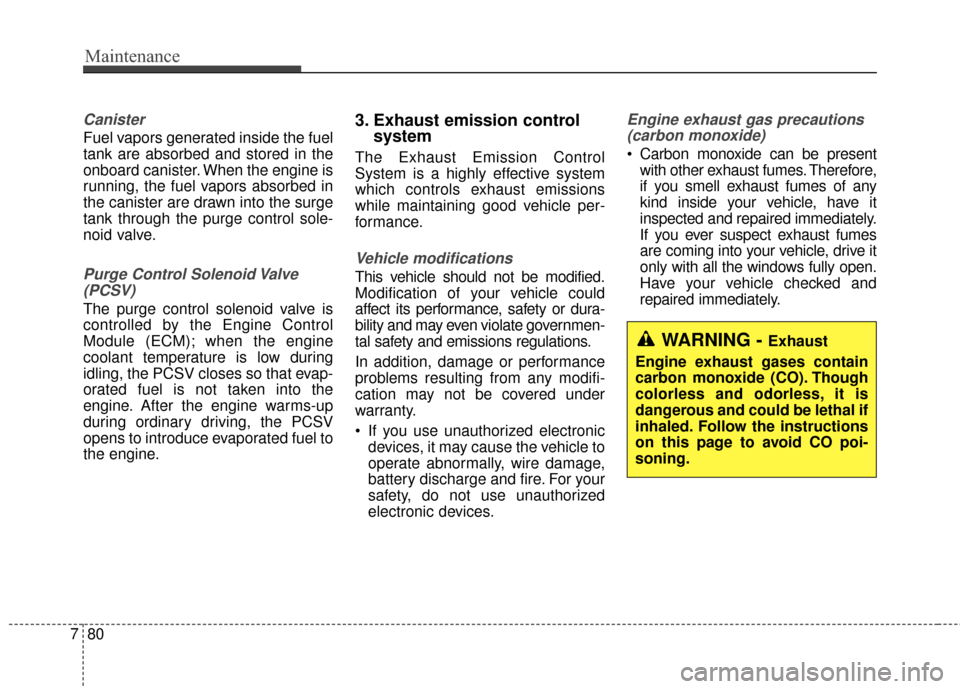
Maintenance
80
7
Canister
Fuel vapors generated inside the fuel
tank are absorbed and stored in the
onboard canister. When the engine is
running, the fuel vapors absorbed in
the canister are drawn into the surge
tank through the purge control sole-
noid valve.
Purge Control Solenoid Valve
(PCSV)
The purge control solenoid valve is
controlled by the Engine Control
Module (ECM); when the engine
coolant temperature is low during
idling, the PCSV closes so that evap-
orated fuel is not taken into the
engine. After the engine warms-up
during ordinary driving, the PCSV
opens to introduce evaporated fuel to
the engine.
3. Exhaust emission control system
The Exhaust Emission Control
System is a highly effective system
which controls exhaust emissions
while maintaining good vehicle per-
formance.
Vehicle modifications
This vehicle should not be modified.
Modification of your vehicle could
affect its performance, safety or dura-
bility and may even violate governmen-
tal safety and emissions regulations.
In addition, damage or performance
problems resulting from any modifi-
cation may not be covered under
warranty.
If you use unauthorized electronic
devices, it may cause the vehicle to
operate abnormally, wire damage,
battery discharge and fire. For your
safety, do not use unauthorized
electronic devices.
Engine exhaust gas precautions (carbon monoxide)
Carbon monoxide can be present with other exhaust fumes. Therefore,
if you smell exhaust fumes of any
kind inside your vehicle, have it
inspected and repaired immediately.
If you ever suspect exhaust fumes
are coming into your vehicle, drive it
only with all the windows fully open.
Have your vehicle checked and
repaired immediately.
WARNING - Exhaust
Engine exhaust gases contain
carbon monoxide (CO). Though
colorless and odorless, it is
dangerous and could be lethal if
inhaled. Follow the instructions
on this page to avoid CO poi-
soning.
Page 498 of 521
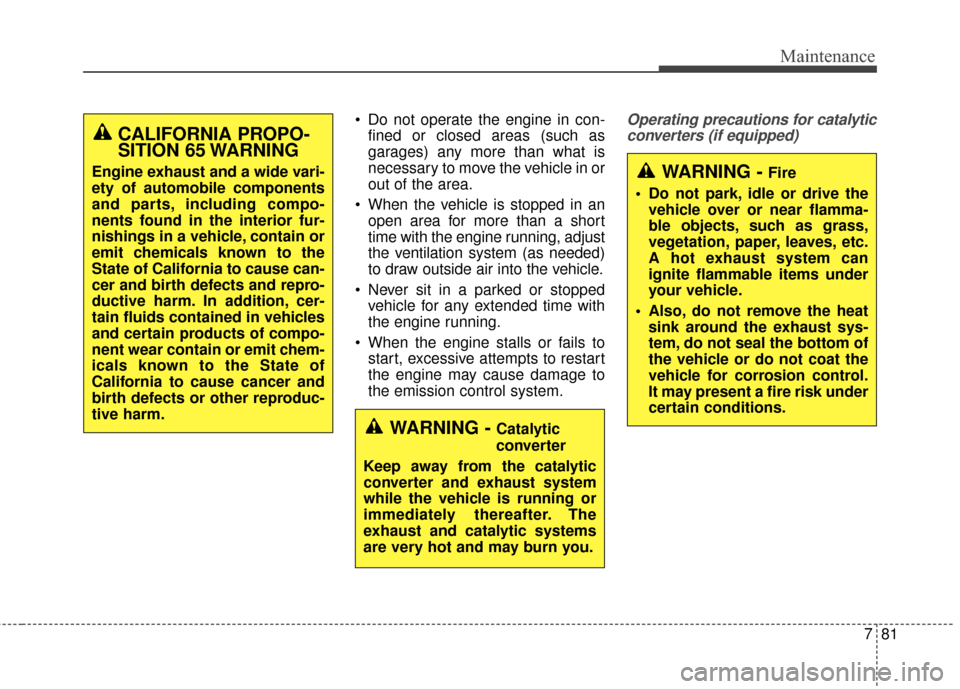
781
Maintenance
Do not operate the engine in con-fined or closed areas (such as
garages) any more than what is
necessary to move the vehicle in or
out of the area.
When the vehicle is stopped in an open area for more than a short
time with the engine running, adjust
the ventilation system (as needed)
to draw outside air into the vehicle.
Never sit in a parked or stopped vehicle for any extended time with
the engine running.
When the engine stalls or fails to start, excessive attempts to restart
the engine may cause damage to
the emission control system.Operating precautions for catalyticconverters (if equipped)
CALIFORNIA PROPO-
SITION 65 WARNING
Engine exhaust and a wide vari-
ety of automobile components
and parts, including compo-
nents found in the interior fur-
nishings in a vehicle, contain or
emit chemicals known to the
State of California to cause can-
cer and birth defects and repro-
ductive harm. In addition, cer-
tain fluids contained in vehicles
and certain products of compo-
nent wear contain or emit chem-
icals known to the State of
California to cause cancer and
birth defects or other reproduc-
tive harm.
WARNING - Catalytic
converter
Keep away from the catalytic
converter and exhaust system
while the vehicle is running or
immediately thereafter. The
exhaust and catalytic systems
are very hot and may burn you.
WARNING - Fire
Do not park, idle or drive the vehicle over or near flamma-
ble objects, such as grass,
vegetation, paper, leaves, etc.
A hot exhaust system can
ignite flammable items under
your vehicle.
Also, do not remove the heat sink around the exhaust sys-
tem, do not seal the bottom of
the vehicle or do not coat the
vehicle for corrosion control.
It may present a fire risk under
certain conditions.
Page 508 of 521
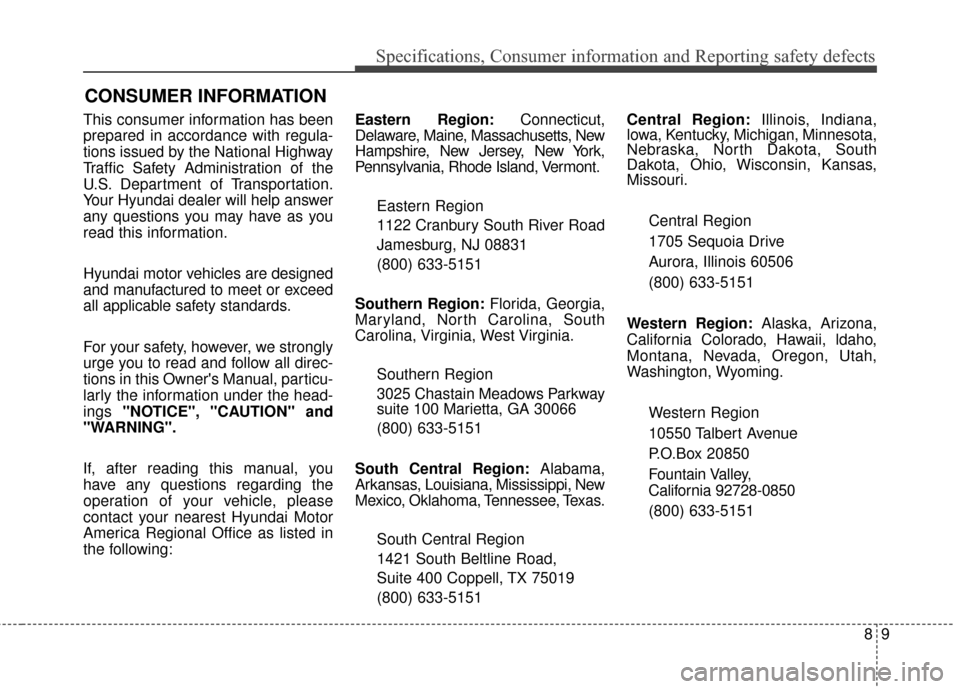
89
Specifications, Consumer information and Reporting safety defects
This consumer information has been
prepared in accordance with regula-
tions issued by the National Highway
Traffic Safety Administration of the
U.S. Department of Transportation.
Your Hyundai dealer will help answer
any questions you may have as you
read this information.
Hyundai motor vehicles are designed
and manufactured to meet or exceed
all applicable safety standards.
For your safety, however, we strongly
urge you to read and follow all direc-
tions in this Owner's Manual, particu-
larly the information under the head-
ings "NOTICE", "CAUTION" and
"WARNING".
If, after reading this manual, you
have any questions regarding the
operation of your vehicle, please
contact your nearest Hyundai Motor
America Regional Office as listed in
the following: Eastern Region:
Connecticut,
Delaware, Maine, Massachusetts, New
Hampshire, New Jersey, New York,
Pennsylvania, Rhode Island, Vermont.
Eastern Region
1122 Cranbury South River Road
Jamesburg, NJ 08831
(800) 633-5151
Southern Region: Florida, Georgia,
Maryland, North Carolina, South
Carolina, Virginia, West Virginia.
Southern Region
3025 Chastain Meadows Parkway
suite 100 Marietta, GA 30066 (800) 633-5151
South Central Region: Alabama,
Arkansas, Louisiana, Mississippi, New
Mexico, Oklahoma, Tennessee, Texas.
South Central Region
1421 South Beltline Road,
Suite 400 Coppell, TX 75019
(800) 633-5151 Central Region:
Illinois, Indiana,
lowa, Kentucky, Michigan, Minnesota,
Nebraska, North Dakota, South
Dakota, Ohio, Wisconsin, Kansas,
Missouri.
Central Region
1705 Sequoia Drive
Aurora, Illinois 60506
(800) 633-5151
Western Region: Alaska, Arizona,
California Colorado, Hawaii, ldaho,
Montana, Nevada, Oregon, Utah,
Washington, Wyoming.
Western Region
10550 Talbert Avenue
P.O.Box 20850
Fountain Valley,
California 92728-0850
(800) 633-5151
CONSUMER INFORMATION
Page 511 of 521
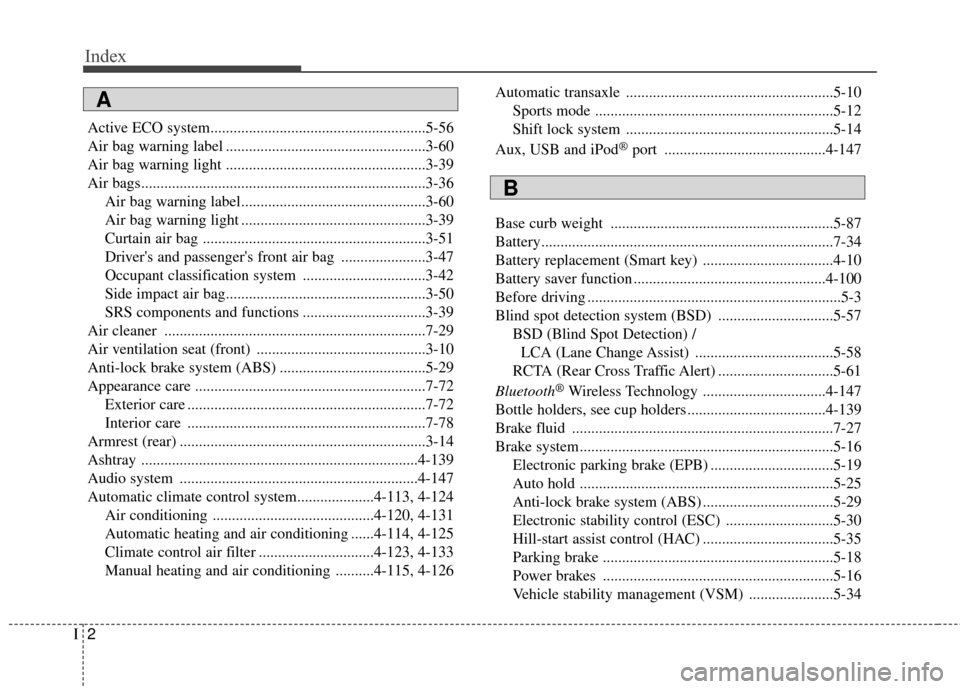
Index
2I
Active ECO system........................................................5-56
Air bag warning label ....................................................3-60
Air bag warning light ....................................................3-39
Air bags........................................................................\
..3-36Air bag warning label................................................3-60
Air bag warning light ................................................3-39
Curtain air bag ..........................................................3-51
Driver's and passenger's front air bag ......................3-47
Occupant classification system ................................3-42
Side impact air bag....................................................3-50
SRS components and functions ................................3-39
Air cleaner ....................................................................7-29\
Air ventilation seat (front) ............................................3-10
Anti-lock brake system (ABS) ......................................5-29
Appearance care ............................................................7-72 Exterior care ..............................................................7-72
Interior care ..............................................................7-78
Armrest (rear) ................................................................3-14
Ashtray ........................................................................\
4-139
Audio system ..............................................................4-147
Automatic climate control system....................4-113, 4-124 Air conditioning ..........................................4-120, 4-131
Automatic heating and air conditioning ......4-114, 4-125
Climate control air filter ..............................4-123, 4-133
Manual heating and air conditioning ..........4-115, 4-126 Automatic transaxle ......................................................5-10
Sports mode ..............................................................5-12
Shift lock system ......................................................5-14
Aux, USB and iPod
®port ..........................................4-147
Base curb weight ..........................................................5-87
Battery........................................................................\
....7-34
Battery replacement (Smart key) ..................................4-10
Battery saver function ..................................................4-100
Before driving ..................................................................5-3
Blind spot detection system (BSD) ..............................5-57 BSD (Blind Spot Detection) / LCA (Lane Change Assist) ....................................5-58
RCTA (Rear Cross Traffic Alert) ..............................5-61
Bluetooth
®Wireless Technology ................................4-147
Bottle holders, see cup holders ....................................4-139
Brake fluid ....................................................................7-27\
Brake system..................................................................5-16 Electronic parking brake (EPB) ................................5-19
Auto hold ..................................................................5-25
Anti-lock brake system (ABS) ..................................5-29
Electronic stability control (ESC) ............................5-30
Hill-start assist control (HAC) ..................................5-35
Parking brake ............................................................5-18
Power brakes ............................................................5-16
Vehicle stability management (VSM) ......................5-34
A
B
Page 514 of 521
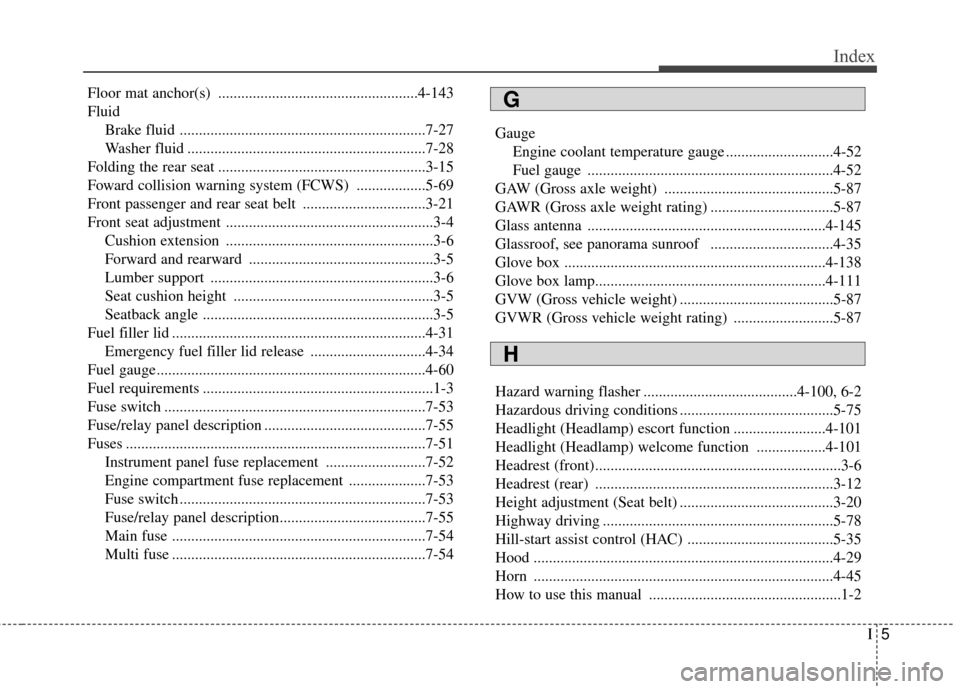
I5
Index
Floor mat anchor(s) ....................................................4-143
FluidBrake fluid ................................................................7-27
Washer fluid ..............................................................7-28
Folding the rear seat ......................................................3-15
Foward collision warning system (FCWS) ..................5-69
Front passenger and rear seat belt ................................3-21
Front seat adjustment ......................................................3-4 Cushion extension ......................................................3-6
Forward and rearward ................................................3-5
Lumber support ..........................................................3-6
Seat cushion height ....................................................3-5
Seatback angle ............................................................3-5
Fuel filler lid ..................................................................4-31 Emergency fuel filler lid release ..............................4-34
Fuel gauge......................................................................4-\
60
Fuel requirements ............................................................1-3
Fuse switch ....................................................................7-53\
Fuse/relay panel description ..........................................7-55
Fuses ........................................................................\
......7-51 Instrument panel fuse replacement ..........................7-52
Engine compartment fuse replacement ....................7-53
Fuse switch ................................................................7-53
Fuse/relay panel description......................................7-55
Main fuse ..................................................................7-54
Multi fuse ..................................................................7-54 Gauge
Engine coolant temperature gauge ............................4-52
Fuel gauge ................................................................4-52
GAW (Gross axle weight) ............................................5-87
GAWR (Gross axle weight rating) ................................5-87
Glass antenna ..............................................................4-145
Glassroof, see panorama sunroof ................................4-35
Glove box ....................................................................4-13\
8
Glove box lamp............................................................4-111
GVW (Gross vehicle weight) ........................................5-87
GVWR (Gross vehicle weight rating) ..........................5-87
Hazard warning flasher ........................................4-100, 6-2
Hazardous driving conditions ........................................5-75
Headlight (Headlamp) escort function ........................4-101
Headlight (Headlamp) welcome function ..................4-101
Headrest (front)................................................................3-6
Headrest (rear) ..............................................................3-12
Height adjustment (Seat belt) ........................................3-20
Highway driving ............................................................5-78
Hill-start assist control (HAC) ......................................5-35
Hood ........................................................................\
......4-29
Horn ........................................................................\
......4-45
How to use this manual ..................................................1-2
H
G